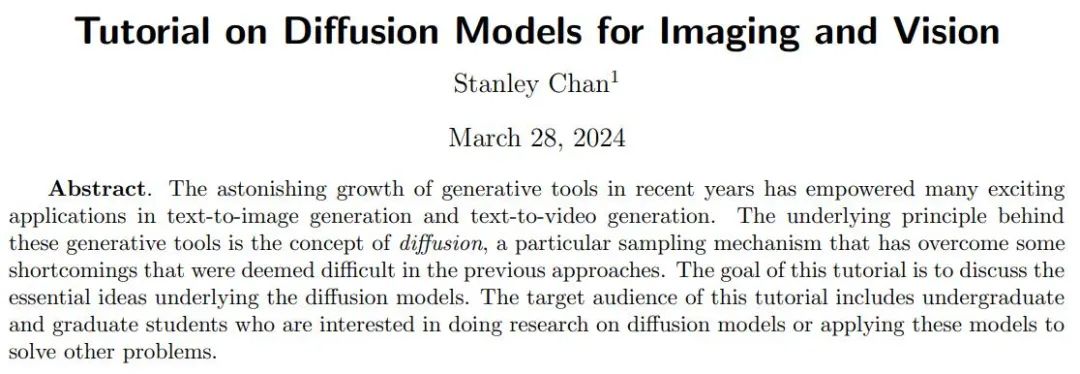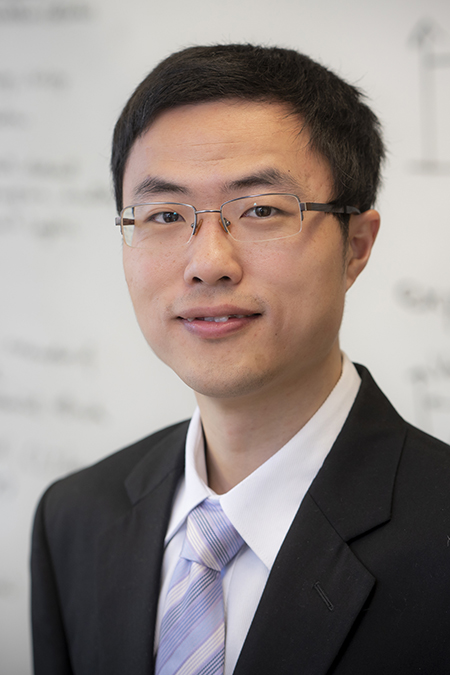A Diffusion Model Tutorial Worth Your Time, from Purdue University
Diffusion can not only imitate better, but also "create".
Diffusion Model is an image generation model. Compared with the well-known algorithms such as GAN and VAE in the field of AI, the diffusion model takes a different approach. Its main idea is a process of first adding noise to the image and then gradually denoising it. How to denoise and restore the original image is the core part of the algorithm. The final algorithm is able to generate an image from a random noisy image.

In recent years, the phenomenal growth of generative AI has enabled many exciting applications in converting text into image generation, video generation, and more. The basic principle behind these generative tools is the concept of diffusion, a special sampling mechanism that overcomes some of the shortcomings of previous methods that were considered difficult to solve.
Recently, Stanley H. Chan from Purdue University released a tutorial on diffusion models "Tutorial on Diffusion Models for Imaging and Vision", which provides an intuitive and detailed explanation of the technology in this direction.
The goal of this tutorial is to discuss the basic ideas of diffusion models. The target audience includes scientists and graduate students interested in diffusion model research. This tutorial will explain the principles of diffusion models and their application to solving other problems so that scientists and graduate students can better understand and apply these models.

Article link: https://arxiv.org/abs/2403.18103
This tutorial consists of four parts covering support diffusion in recent research literature Some basic concepts of generative models: Variational Autoencoder (VAE), Denoising Diffusion Probabilistic Model (DDPM), Langevin Dynamics Score Matching (SMLD) and SDE. These models independently derive the same diffusion ideas from multiple perspectives and are 50 pages long.

Introduction to the author
The author of this tutorial is Elmore Associate Professor, School of Electrical and Computer Engineering and Department of Statistics, Purdue University, USA Stanley H. Chan.

In 2007, Stanley Chan received his bachelor's degree from the University of Hong Kong, and then obtained his master's degree in mathematics and PhD in electrical engineering from the University of Canada, San Diego in 2009 and 2011 respectively. From 2012 to 2014, he served as a postdoctoral fellow at the Harvard John A. Paulson School of Engineering and Applied Sciences. Joined Purdue University in 2014.
Stanley Chan is mainly engaged in computational imaging research. His research mission is to build smart cameras by co-designing sensors and algorithms to enable visibility in all imaging conditions.
Stanley Chan has also won multiple paper awards, including the 2022 IEEE Signal Processing Society (SPS) Best Paper Award, the 2016 IEEE International Conference on Image Processing (ICIP) Best Paper Award, etc.

Reference link:
https://engineering.purdue.edu/ChanGroup/stanleychan. html
The above is the detailed content of A Diffusion Model Tutorial Worth Your Time, from Purdue University. For more information, please follow other related articles on the PHP Chinese website!

Hot AI Tools

Undresser.AI Undress
AI-powered app for creating realistic nude photos

AI Clothes Remover
Online AI tool for removing clothes from photos.

Undress AI Tool
Undress images for free

Clothoff.io
AI clothes remover

AI Hentai Generator
Generate AI Hentai for free.

Hot Article

Hot Tools

Notepad++7.3.1
Easy-to-use and free code editor

SublimeText3 Chinese version
Chinese version, very easy to use

Zend Studio 13.0.1
Powerful PHP integrated development environment

Dreamweaver CS6
Visual web development tools

SublimeText3 Mac version
God-level code editing software (SublimeText3)

Hot Topics
 1378
1378
 52
52
 A Diffusion Model Tutorial Worth Your Time, from Purdue University
Apr 07, 2024 am 09:01 AM
A Diffusion Model Tutorial Worth Your Time, from Purdue University
Apr 07, 2024 am 09:01 AM
Diffusion can not only imitate better, but also "create". The diffusion model (DiffusionModel) is an image generation model. Compared with the well-known algorithms such as GAN and VAE in the field of AI, the diffusion model takes a different approach. Its main idea is a process of first adding noise to the image and then gradually denoising it. How to denoise and restore the original image is the core part of the algorithm. The final algorithm is able to generate an image from a random noisy image. In recent years, the phenomenal growth of generative AI has enabled many exciting applications in text-to-image generation, video generation, and more. The basic principle behind these generative tools is the concept of diffusion, a special sampling mechanism that overcomes the limitations of previous methods.
 An article summarizing the application of Diffusion Model in time series
Mar 07, 2024 am 10:30 AM
An article summarizing the application of Diffusion Model in time series
Mar 07, 2024 am 10:30 AM
The diffusion model is currently the core module in generative AI and has been widely used in large generative AI models such as Sora, DALL-E, and Imagen. At the same time, diffusion models are increasingly being applied to time series. This article introduces you to the basic ideas of the diffusion model, as well as several typical works of the diffusion model used in time series, to help you understand the application principles of the diffusion model in time series. 1. Diffusion model modeling idea The core of the generative model is to be able to sample a point from a random simple distribution and map this point to an image or sample in the target space through a series of transformations. The method of diffusion model is to continuously remove noise on the sampled sample points, and after multiple noise removal steps, the final data is generated.
 Generate PPT with one click! Kimi: Let the 'PPT migrant workers' become popular first
Aug 01, 2024 pm 03:28 PM
Generate PPT with one click! Kimi: Let the 'PPT migrant workers' become popular first
Aug 01, 2024 pm 03:28 PM
Kimi: In just one sentence, in just ten seconds, a PPT will be ready. PPT is so annoying! To hold a meeting, you need to have a PPT; to write a weekly report, you need to have a PPT; to make an investment, you need to show a PPT; even when you accuse someone of cheating, you have to send a PPT. College is more like studying a PPT major. You watch PPT in class and do PPT after class. Perhaps, when Dennis Austin invented PPT 37 years ago, he did not expect that one day PPT would become so widespread. Talking about our hard experience of making PPT brings tears to our eyes. "It took three months to make a PPT of more than 20 pages, and I revised it dozens of times. I felt like vomiting when I saw the PPT." "At my peak, I did five PPTs a day, and even my breathing was PPT." If you have an impromptu meeting, you should do it
 All CVPR 2024 awards announced! Nearly 10,000 people attended the conference offline, and a Chinese researcher from Google won the best paper award
Jun 20, 2024 pm 05:43 PM
All CVPR 2024 awards announced! Nearly 10,000 people attended the conference offline, and a Chinese researcher from Google won the best paper award
Jun 20, 2024 pm 05:43 PM
In the early morning of June 20th, Beijing time, CVPR2024, the top international computer vision conference held in Seattle, officially announced the best paper and other awards. This year, a total of 10 papers won awards, including 2 best papers and 2 best student papers. In addition, there were 2 best paper nominations and 4 best student paper nominations. The top conference in the field of computer vision (CV) is CVPR, which attracts a large number of research institutions and universities every year. According to statistics, a total of 11,532 papers were submitted this year, and 2,719 were accepted, with an acceptance rate of 23.6%. According to Georgia Institute of Technology’s statistical analysis of CVPR2024 data, from the perspective of research topics, the largest number of papers is image and video synthesis and generation (Imageandvideosyn
 Five programming software for getting started with learning C language
Feb 19, 2024 pm 04:51 PM
Five programming software for getting started with learning C language
Feb 19, 2024 pm 04:51 PM
As a widely used programming language, C language is one of the basic languages that must be learned for those who want to engage in computer programming. However, for beginners, learning a new programming language can be difficult, especially due to the lack of relevant learning tools and teaching materials. In this article, I will introduce five programming software to help beginners get started with C language and help you get started quickly. The first programming software was Code::Blocks. Code::Blocks is a free, open source integrated development environment (IDE) for
 From bare metal to a large model with 70 billion parameters, here is a tutorial and ready-to-use scripts
Jul 24, 2024 pm 08:13 PM
From bare metal to a large model with 70 billion parameters, here is a tutorial and ready-to-use scripts
Jul 24, 2024 pm 08:13 PM
We know that LLM is trained on large-scale computer clusters using massive data. This site has introduced many methods and technologies used to assist and improve the LLM training process. Today, what we want to share is an article that goes deep into the underlying technology and introduces how to turn a bunch of "bare metals" without even an operating system into a computer cluster for training LLM. This article comes from Imbue, an AI startup that strives to achieve general intelligence by understanding how machines think. Of course, turning a bunch of "bare metal" without an operating system into a computer cluster for training LLM is not an easy process, full of exploration and trial and error, but Imbue finally successfully trained an LLM with 70 billion parameters. and in the process accumulate
 PyCharm Community Edition Installation Guide: Quickly master all the steps
Jan 27, 2024 am 09:10 AM
PyCharm Community Edition Installation Guide: Quickly master all the steps
Jan 27, 2024 am 09:10 AM
Quick Start with PyCharm Community Edition: Detailed Installation Tutorial Full Analysis Introduction: PyCharm is a powerful Python integrated development environment (IDE) that provides a comprehensive set of tools to help developers write Python code more efficiently. This article will introduce in detail how to install PyCharm Community Edition and provide specific code examples to help beginners get started quickly. Step 1: Download and install PyCharm Community Edition To use PyCharm, you first need to download it from its official website
 A must-read for technical beginners: Analysis of the difficulty levels of C language and Python
Mar 22, 2024 am 10:21 AM
A must-read for technical beginners: Analysis of the difficulty levels of C language and Python
Mar 22, 2024 am 10:21 AM
Title: A must-read for technical beginners: Difficulty analysis of C language and Python, requiring specific code examples In today's digital age, programming technology has become an increasingly important ability. Whether you want to work in fields such as software development, data analysis, artificial intelligence, or just learn programming out of interest, choosing a suitable programming language is the first step. Among many programming languages, C language and Python are two widely used programming languages, each with its own characteristics. This article will analyze the difficulty levels of C language and Python




